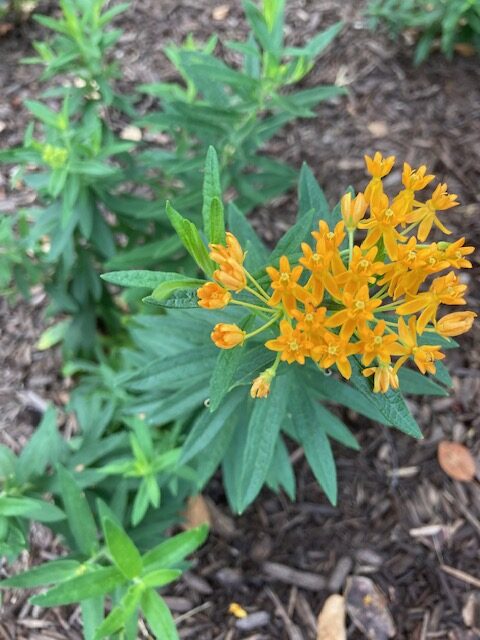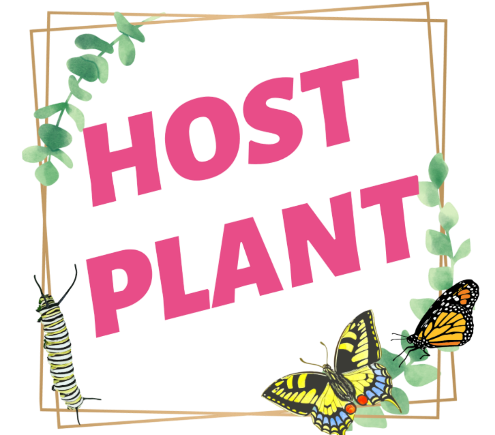
Milkweed (Butterfly Flower)
Milkweed is the only host plant for the Monarch butterfly. As populations are declining it is a pretty plant to add to pollinator gardens. Asclepias tuberose is a native to GA and has either orange or yellow blooms.
|
Asclepias tuberose Swamp |
|
Asclepias tuberose Swamp: Asclepias incarnata |
|
Difficult to Easy |
|
Intermediate |
|
2-3 years if properly stored |
|
Perennial |
|
14-21 days |
|
Cold Stratification 6-8 weeks |
|
1/4 inch |
|
3 feet |
|
Full sun |
|
Asclepias tuberose; Swamp: Summer |
|
November and January Special Seed Library Event |
|
Yes |

Asclepias tuberose, Native GA milkweed. Picture by Elizabeth Jones
Growing Tips




Asclepias tuberose is native to much of the U. S. including GA.
Asclepias incarnata is native to most of GA, including Jefferson.
When to Start
**PLANNING NEEDED**
Fall: Direct sow after the first frost. (Mid-November for GA) Seedlings should sprout the following Spring.
Spring: Seeds require cold stratification. For GA, this process starts in January.
The entire process from starting to transplant will take about 4 months.
- Grab a calendar.
- Twelve to sixteen weeks before transplanting, place the seed in the refrigerator. This step is critical; without it, the seeds may not germinate. This is anywhere from early to late January, for GA. Leave seeds in the refrigerator for 6-8 weeks.
- After the designated time has passed, remove the seeds from the refrigerator and start them indoors. This is 6-8 weeks before transplanting. Early to mid-March for GA.
- Let the seedlings grow for 6-8 weeks. Harden off before transplanting. Transplant after all danger of frost has passed (May 1 for Jefferson, GA).
How to Start
The seeds need either overwintering for direct sowing in the Fall or cold stratification for Spring planting. Without this cold exposure process, the seeds won’t germinate.
Direct sow (Fall) to a depth of ¼ inch after the first frost. The average first frost for Jefferson, GA is November 15.
For spring planting. Start seeds 12-16 weeks before the last frost date. This is January for Jefferson, GA. Start seeds in seed starting mix. Sow to a depth of 1/4 to 1/2 inch. Place the seed cells in a plastic bag. You may need to use a piece of cardboard to support the cells so they don’t tip over. Place the bag in the refridgerator for 6-8 weeks to cold-stratify. Keep the soil moist and check on it to make sure no mold is growing. After cold-stratification remove the cells or pots and place them under grow lights. This will be 6-8 weeks before the transplant date. (Mid March for Jefferson, GA.)
Pot up as needed and keep them moist, but not soggy. Transplant after ALL danger of frost has passed (May 1 for Jefferson, GA) into full sun beds. Space plants 18-24 inches apart.
Care
They prefer well-draining soil. However, butterfly weed will tolerate a variety of soils as long as it’s not consistently dry or overly sandy. Once butterfly weed is established it is easy to take care of it and is drought tolerant. The tricky part is starting them from seed and all the planning that is required. It prefers soil on the dryer side. Unless you have a swamp variety (A. incarnata), then it likes consistently moist soil.
Also, keep in mind that butterfly weed has long, sturdy roots that make transplantation very difficult, so locate the plant in its permanent place in the garden.
Trim old growth every spring to keep them neat and healthy. Dead-head plant to encourage more blossoms. But, leave some to save the seeds.
They will get aphids on them, but they don’t do much harm to the plant and anything you might do to kill the aphids, will also harm the butterflies. So, leaving them alone is best.
Special Note:
Butterfly weed is the only plant on which the Monarch butterflies lay their eggs. This is a crucial plant for the life cycle of the Monarch butterfly. If you see caterpillars or leaf damage, this is most likely due to Monarch butterfly larvae. We recommend you leave them alone and allow them to mature into butterflies. Should you choose to plant milkweed to help increase the Monarch population, you will need a minimum of 8-10 plants so the caterpillars don’t starve.
My Personal Experience:
The Jefferson Public Library’s garden is part of the Rosalynn Carter Butterfly Trail. I started our Asclepias tuberose plants indoors and found the seeds to be fairly easy to cold-stratify and start. It’s still weird to place ‘dirt’ in the refrigerator.
Our plants survived the 14 F temps we had for 4 days in 2022. The plants did die back to the soil and I thought they’d been lost, but the roots survived the plants grew again the following spring!
Seed Saving

Isolation Distance
Insect dependent for pollination. Isolate 1/2 mile to prevent cross-pollination.
Instructions
Select healthy, robust plants free of any signs of disease or insect infestation for seeds. Seeds carry the traits of the parent plant. Choose plants that exhibit the traits you wish to preserve. Consider bloom size, color, and shape, as well as blooming time.
Allow the biggest and healthiest blooms to mature on the plant. Cover the seed head with a fine-mesh bag as soon as the flower petals shrivel and die. Use an elastic band to hold the bag in place. This prevents seeds from spilling onto the soil before harvest.
Clip the flower head from the main stem once the seeds are dry and dark. Separate plant debris from the seeds by removing the mesh bag and placing the flower head in a paper bag and shaking to loosen the seeds. Seeds settle to the bottom of the bag. Remove plant debris by hand.
Features
- Good cut flowers
- Attracts pollinators
-
Both A. tuberose A. speciosa are host plants for the Monarch butterfly
- Self-seeds
- Low maintenance (once established)
- Attracts pollinators
- Asclepias tuberose: Heirloom and a GA native flower. Mature butterflies of all kinds feed on the nectar produced in the flowers, making it perfect for pollinator gardens. The foliage provides food for the monarch butterfly larvae. The flowers are brilliant orange and yellow and are very showy in mass plantings. They are long-lived and hardy plants. CAUTION: The milky sap is poisonous if ingested in large quantities, and contact with the skin may cause dermatitis in sensitive individuals.

Plant away from where pets frequent as the sap of Asclepias is toxic.
To determine when to place the seeds in the refrigerator, count backward 12-16 weeks from the transplant date. This is the date to place them in the refrigerator.
